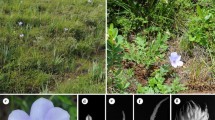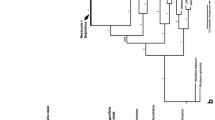Abstract
The phylogeny of suprageneric groups inCyperaceae has been examined by cladistic analysis ofrbcL sequence data of 80 species in 40 genera. The results support the family as monophyletic and derived from a juncaceous grade.Oxychloe (Juncaceae) has moderate support as the sister taxon toCyperaceae. Several monophyletic groups correspond to previously recognised tribes, and some similarities are noted between this analysis and previous cladistic analyses of primarily morphological data. Support is also given for the removal ofHellmuthia from tribeHypolytreae, the transfer ofIsolepis nodosa toFicinia, and the inclusion ofOxycaryum andKyllingiella in tribeCypereae. A polytomy comprisingCyperus, Juncellus, Kyllinga andPycreus indicates a broader circumscription ofCyperus. The greatest uncertainty lies with the generic and tribal status of theScirpeae.
Similar content being viewed by others
References
Bentham, G., 1883:Cyperaceae. — InBentham, G., Hooker, J. D., (Eds): Genera plantarum,3, pp. 1037–1073. — London.
Browning, J., Gordon-Gray, K. D., 1995: Studies inCyperaceae in southern Africa.24: Three species ofScirpoides. — S. African J. Bot.60: 315–320.
Bruhl, J. J., 1991: Comparative development of some taxonomically critical floral/inflorescence features inCyperaceae. — Austral. J. Bot.39: 119–127.
, 1995: Sedge genera of the world: relationships and a new classification of theCyperaceae. — Austral. Syst. Bot.8: 125–305.
Chase, M. W., Soltis, D. E., Olmstead, R. G., Morgan, D., Les, D. H., Mishler, B. D., Duvall, M. R., Price, R. A., Hills, H. G., Qiu, Y.-L., Kron, K. A., Rettig, J. H., Conti, E., Palmer, J. D., Manhart, J. R., Sytsma, K. J., Michaels, H. J., Kress, W. J., Karol, K. G., Clark, W. D., Hedrén, M., Gaut, B. S., Jansen, R. K., Kim, K. -J., Wimpee, C. F., Smith, J. F., Furnier, G. R., Strauss, S. H., Xiang, Q. -Y., Plunkett, G. M., Soltis, P. S., Swenson, S. M., Williams, S. E., Gadek, P. A., Quinn, C. J., Eguiarte, L. E., Golenberg, E., Learn Jr., G. H., Graham, S. W., Barrett, S. C. H., Dayanandan, S., Albert, V. A., 1993: Phylogenetics of seed plants: an analysis of nucleotide sequences from the plastid generbcL. — Ann. Missouri Bot. Gard.80: 528–586.
Chase, M. W., Stevenson, D. W., Wilkin, P., Rudall, P. J., 1995: Monocot systematics: a combined analysis. — InRudall, P. J., Cribb, P. J., Cutler, D. F., Humphries, C. J., (Eds): Monocotyledons — systematics and evolution, pp. 685–730. — Richmond: Royal Botanic Gardens, Kew.
Clarke, C. B., 1908: New genera and species ofCyperaceae. — Bull. Misc. Inf., Kew, Addit. Ser.8: 1–196.
Cronquist, A., 1988: The evolution and classification of flowering plants. 2nd edn. — New York: New York Botanical Garden.
Dahlgren, R., Clifford, H. T., Yeo, P. F., 1985: The families of the monocotyledons. — Berlin, Heidelberg, New York: Springer.
Dallwitz, M. J., Paine, T. A., Zurcher, E. J., 1993: ‘User's guide to the DELTA system’. — East Melbourne: CSIRO Division of Entomology.
Doebley, J., Durbin, M., Golenberg, E. M., Clegg, M. T., Ma, D. P., 1990: Evolutionary analysis of the large subunit of carboxylase (rbcL) nucleotide sequence among the grasses (Gramineae). — Evolution44: 1097–1108.
Doyle, J. J., Doyle, J. L., 1987: A rapid DNA isolation procedure for small quantities of fresh leaf tissue. — Phytochem. Bull.19: 11–15.
Duvall, M. R., Clegg, M. T., Chase, M. W., Clark, W. D., Kress, W. J., Hills, H. G., Eguiarte, L. E., Smith, J. F., Gaut, B. S., Zimmer, E. A., Learn, G. H., Jr., 1993: Phylogenetic hypotheses for the monocotyledons constructed fromrbcL sequence data. — Ann. Missouri Bot. Gard.80: 607–619.
Farris, J. S., 1969: A successive approximation approach to character weighting. — Syst. Zool.18: 374–385.
, 1996: Parsimony jackknifing outperforms neighbor-joining. — Cladistics12: 99–124.
Felsenstein, J., 1995: Confidence limits on phylogenies: an approach using the bootstrap. — Evolution39: 783–793.
Fitch, W. M., 1971: Toward defining the course of evolution: minimum change for a specified tree topology. — Syst. Zool.20: 406–416.
Goetghebeur, P., 1986: Genera Cyperacearum. — Dr. Sci. Thesis, State University, Ghent.
, 1989: Studies inCyperaceae 9. Problems in the lectotypification and infrageneric taxonomy ofCyperus L. — Bull. Soc. Roy. Belg.122: 103–114.
Gordon-Gray, K. D., 1995:Cyperaceae in Natal. — Strelitzia2: 1–218.
Haines, R. W., Lye, K. A., 1976: Studies in AfricanCyperaceae 14. The genusHellmuthia Steud. — Bot. Not.129: 61–67.
, 1983: The sedges and rushes of East Africa. — Nairobi: East African Natural History Society.
Holttum, R. E., 1948: The spikelet inCyperaceae. — Bot. Rev.14: 525–541.
Hudson, G. S., Mahon, J. D., Anderson, P. A., Gibbs, M. J., Badger, M. R., Andrews, T. J., Whitfeld, P. R., 1990: Comparison ofrbcL genes for the large subunit of ribulosebisphosphate carboxylase from closely related C3 and C4 plant species. — J. Biol. Chem.265: 808–814.
Jussieu, A. L. de, 1789: Genera plantarum secundum ordines naturalis disposita. — Paris: Herissant & Barrois.
Kellogg, K. A., Juliano, N. D., 1997: The structure and function of RuBisCo and their implications for systematic studies. — Amer. J. Bot.84: 413–428.
Kern, J. H., 1974:Cyperaceae. — Invan Steenis, C. G. G. J., (Ed.): Flora Malesiana1(7: 435–753.
Koyama, T., 1961: Classification of the familyCyperaceae 1. — J. Fac. Sci. Univ. Tokyo, Sect. 3, Bot.8: 37–148.
Kükenthal, G., 1936:Cyperaceae — Scirpoideae — Cypereae. — InEngler, A., Diels, A., (Eds): Das Pflanzenreich,IV, 20/101. — Berlin: Engelmann.
Kunth, C. S., 1837: Enumeratio plantarum.2. — Stuttgart, Tübingen.
Nees von Esenbeck, C. G., 1835: Übersicht der Cyperaceengattungen. — Linnaea9: 273–306.
Nishizawa, Y., Hirai, A., 1987: Nucleotide sequence and expression of the gene for the large subunit of the ribulose 1,5-bisphosphate carboxylase. — Jap. J. Genet.62: 389–395.
Olmstead, R. G., Michaels, H. J., Scott, K. M., Palmer, J. D., 1992: Monophyly of theAsterideae and the identification of their major lineages inferred from DNA sequences ofrbcL. — Ann. Missouri Bot. Gard.79: 249–265.
Partridge, T. R., Dallwitz, M. J., Watson, L., 1993: Delta Primer. A general system for processing taxonomic descriptions. — East Melbourne: CSIRO Division of Entomology.
Plunkett, G. M., Soltis, D. E., Soltis, P. S., Brooks, R. E., 1995: Phylogenetic relationships betweenJuncaceae andCyperaceae based onrbcL sequence data. — Amer. J. Bot.82: 520–525.
Sheahan, M. C., Chase, M. W., 1996: A phylogenetic analysis ofZygophyllaceae R. Br. based on morphological, anatomical andrbcL DNA sequence data. — Bot. J. Linn. Soc.122: 279–300.
Simpson, D. A., 1993: Genera ofCyperaceae recognised at Kew. — Cyp. Newsl.12: 8–12.
, 1995: Relationships withinCyperales. — InRudall, P. J., Cribb, P. J., Cutler, D. F., Humphries, C. J., (Eds): Monocotyledons — systematics and evolution, pp. 497–509. — Richmond: Royal Botanic Gardens, Kew.
Soltis, D. E., Soltis, P. S., Nickrent, D. L., Johnson, L. A., Hahn, W. J., Hoot, S. B., Sweere, J. A., Kuzoff, R. K., Kron, K. A., Chase, M. W., Swensen, S. M., Zimmer, E. A., Chaw, S.-M., Gillespie, L. J., Kress, W. J., Sytsma, K. J., 1997: Angiosperm phylogeny inferred from 18S ribosomal DNA sequences. — Ann. Missouri Bot. Gard.84: 1–49.
Swofford, D. L., 1993: PAUP: phylogenetic analysis using parsimony, version 3.1.1. — Champaign, Illinois: Illinois Natural History Survey.
Takhtajan, A. L., 1980: Outline of the classification of flowering plants. — Bot. Rev.46: 225–359.
Veken, P. van der, 1965: Contribution a l' embryographie systématique desCyperaceae — Cyperoideae. — Bull. Jard. Bot. État25: 285–354.
Wilson, K. L., 1981: A synopsis of the genusScirpus sens. lat. (Cyperaceae) in Australia. — Telopea2: 153–172.
Author information
Authors and Affiliations
Rights and permissions
About this article
Cite this article
Muasya, A.M., Simpson, D.A., Chase, M.W. et al. An assessment of suprageneric phylogeny inCyperaceae usingrbcL DNA sequences. Pl Syst Evol 211, 257–271 (1998). https://doi.org/10.1007/BF00985363
Received:
Revised:
Accepted:
Issue Date:
DOI: https://doi.org/10.1007/BF00985363




